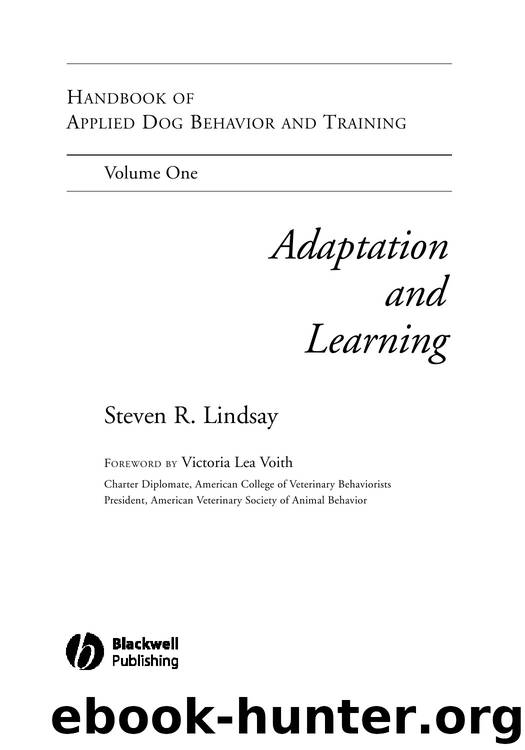Handbook of Applied Dog Behavior and Training, Volume 1 by Adaptation; Learning

Author:Adaptation; Learning
Language: eng
Format: mobi
Published: 2011-11-10T00:07:14+00:00
208
CHAPTER SIX
ability of US is higher during CS than at other
dently of the presence or absence of the CS,
times, excitatory condition occurs; when the
the CS is neutralized (Rescorla, 1967).
probability is lower, inhibitory conditioning re-
Rescorla’s important discovery suggests that
sults. Notice that the probability of a US can
classical conditioning is a contingency-based
be the same in the absence and presence of CS
process in which the CS functions as a statis-
and yet there can be a fair number of CS-US
tically informative signal about the probabil-
pairings. It is this that makes it possible to as-
sess the relative importance of pairing and
ity of the occurrence or nonoccurrence of the
contingency in the development of a CR.
US (Fig. 6.4).
(1968:1)
As a supplement or correction to the con-
tiguity theory, the contingency theory pro-
Rescorla interprets conditioning from a cog-
vides a coherent and elegant way to describe
nitive viewpoint attributing both predictive
what takes place during classical condition-
and informative properties to the CS. The
ing. Besides predicting the occurrence of the
model places equal importance on the pres-
US, the CS also provides information about
ence as well as the absence of the CS in rela-
the type and size (magnitude) of the antici-
tion to the occurrence of the US. According
pated UR, as well as various significant con-
to Rescorla, associative conditioning depends
textual relations between the occurrence of
on a predictive contingency (both positive
the CS and CR. But, as Rescorla writes, “It is
and negative) holding between the CS and
not only temporal and logical relations
US. If the US occurs regardless of the pres-
among events that are important to condi-
ence or absence of the CS (i.e., the US occurs
tioning. Conditioning is also sensitive to rela-
independently of the CS), then in spite of
tions involving the properties of the events
many chance pairings between the CS and
themselves” (1988:153).
US (all being offset by an equal number of
Formulating predictions about such infor-
US events occurring without the CS), no ef-
mation requires that the CS be somehow as-
fective conditioning takes place. Under con-
sociatively linked with the US eliciting the
ditions in which the US occurs indepen-
UR. The so-called stimulus-stimulus (S-S)
1.0
.9
Excitatory conditioning
.8
No conditioning
.7
.6
.5
(US/CS) p .4
Inhibitory conditioning
.3
.2
.1
.1
.2
.3
.4
.5
.6
.7
.8
.9
1.0
p (US/no CS)
FIG. 6.4. Probability ( p) space describing excitatory and inhibitory conditioning. CS, conditioned stimulus; US, unconditioned stimulus.
Classical Conditioning
209
theory of classical conditioning asserts that
sical conditioning also yields information
the connection between CS and US events is
about the size and type of anticipated stimula-
mediated by control centers in the brain, per-
tion. According to Rescorla, the size or mag-
haps corresponding to Gray’s septal-hip-
nitude of the CR depends on the associative
pocampal comparator system, “a system
strength acquired by the CS together with the
which, moment to moment predicts the next
stimulus intensity of the original US. For in-
likely event and compares this prediction to
stance, a CS paired with an electric shock will
the actual event” (Gray, 1991:112) (see
yield a stronger avoidance response than a
Chapter 3).
similar CS paired with a light slap on the
Predictions about the size of the US are
hands. Additionally, the magnitude of the CR
estimated along an excitatory-inhibitory di-
is influenced by the salience of the eliciting
mension. If the CS underestimates the size of
CS. For instance, a softly spoken reprimand
the pending US, excitatory learning takes
will yield only a small response from a dog,
place ( acquisition).
Download
This site does not store any files on its server. We only index and link to content provided by other sites. Please contact the content providers to delete copyright contents if any and email us, we'll remove relevant links or contents immediately.
Sapiens: A Brief History of Humankind by Yuval Noah Harari(13990)
The Tidewater Tales by John Barth(12392)
Mastermind: How to Think Like Sherlock Holmes by Maria Konnikova(6937)
Do No Harm Stories of Life, Death and Brain Surgery by Henry Marsh(6687)
The Thirst by Nesbo Jo(6439)
Why We Sleep: Unlocking the Power of Sleep and Dreams by Matthew Walker(6353)
Life 3.0: Being Human in the Age of Artificial Intelligence by Tegmark Max(5187)
Sapiens by Yuval Noah Harari(5123)
The Longevity Diet by Valter Longo(4859)
The Body: A Guide for Occupants by Bill Bryson(4584)
The Rules Do Not Apply by Ariel Levy(4524)
The Immortal Life of Henrietta Lacks by Rebecca Skloot(4257)
Why We Sleep by Matthew Walker(4190)
Animal Frequency by Melissa Alvarez(4150)
Yoga Anatomy by Kaminoff Leslie(4103)
The Hacking of the American Mind by Robert H. Lustig(4086)
All Creatures Great and Small by James Herriot(3986)
Barron's AP Biology by Goldberg M.S. Deborah T(3944)
Double Down (Diary of a Wimpy Kid Book 11) by Jeff Kinney(3927)
